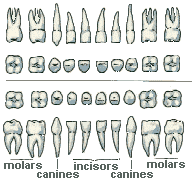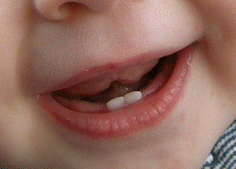
Baby Teeth (Deciduous or Primary Teeth)
Baby teeth, also known as primary, milk or deciduous teeth, are the first set of teeth that humans get in their lives. The 20 primary teeth start to appear in a baby’s mouth after the sixth month and they stay in the mouth of the child until they are gradually replaced by the permanent teeth between the ages of 6 to twelve years.
Baby teeth development
The baby teeth start to develop from the 6th to 8th week of fetal life from epithelium cells of the mouth that form the tooth buds. The cells of these initial tooth germs continue to differentiate during pregnancy and by the time the baby is born most teeth are already partially formed in the jaws. They are not yet visible in the mouth but with an x-ray we can see all the primary teeth under the gums in various phases of development.
Primary teeth number, morphology and anatomy
When the primary dentition is completed, children have a set of 20 primary teeth, ten at every jaw. They belong to 3 different teeth types: 8 incisors, 4 canines, and 8 molars.
Their internal anatomy is the same as in permanent teeth. Externally the tooth is covered by a layer of enamel at the crown area and by cementum at the root area. Under the enamel there is a layer of dentine which surrounds the soft and alive dental pulp at the center of the tooth. The morphology of baby teeth is also generally similar with that of permanent teeth.
There are only 20 primary teeth vs. 32 permanent teeth. The other main differences between the primary and permanent dentition are:
- Smaller size
- No premolars
- Thinner and more translucent enamel
- Less mineralized enamel (which makes primary teeth more vulnerable to cavities)
- Larger pulp chambers
- Narrower and smaller roots
- Primary teeth fall out to give place to permanent teeth
Primary teeth eruption
Teeth eruption is the process of teeth moving towards the surface of the jawbone and breaking through the gums until they take their final position in the mouth with their crown fully visible. At this point the crown is completely formed but the root of the tooth will continue to form for one more year.
The process of tooth eruption is usually accompanied with pain and discomfort for the baby. The associated symptoms such as drooling, disruptions in eating or sleeping patterns, irritability, swollen gums are referred as ‘teething’. Massaging gently the baby's gums or giving to the baby to bite a chilled teething ring, a cool spoon or a cold, wet washcloth can help ease the discomfort.

When do babies start teething?
The period of primary teeth eruption starts with the central incisors of the lower jaw between the sixth month of life and the first birthday of the child, and it is fully completed by the 3rd year of age with the appearance of the upper second molar. By the age of 6 years the eruption of the first permanent molar marks the end of the primary dentition period and the start of mixed dentition.
Baby teeth order of eruption
Although tooth eruption of specific primary teeth may occur at different times for different children, dentists accept that there is a general eruption pattern and timeline. It must be noted that there is considerable variation in their range. The eruption times discussed in dental literature should be considered only as ‘average’ or ‘most common’. Significant differences have been noted in the tooth eruption patterns between sexes and racial groups.
The timing of the first tooth eruption differs from child to child. But from that point on, the time intervals and the order of baby teeth eruption are generally following a standard pattern.
The following chart shows when each primary tooth is expected to erupt. As you can see in the chart, there is an interval of several months in which each baby tooth will possibly erupt. Although it is expected that in some children the eruption time may be outside these limits, it is advised to contact a pediatric dentist if you notice that a tooth of your baby has an eruption delay of several months.
| Primary Teeth Chart - Baby Teeth Order of Eruption | |||
| Tooth | Age of Tooth Eruption (months) |
Age when tooth falls out (years) |
Age of Root completion (years) |
| Upper Primary Teeth | |||
| Central Incisor | 8 to 12 m | 6 to 7 y | 1.5 |
| Lateral Incisor | 9 to 13 m | 7 to 8 y | 2 |
| Cuspid | 16 to 22 m | 10 to 12 y | 3.25 |
| First Molar | 13 to 19 m | 9 to 11 y | 1.5 |
| Second Molar | 25 to 33 m | 10 to 12 y | 3 |
| Lower Primary Teeth | |||
| Central Incisor | 6 to 10 m | 6 to 7 y | 1.5 |
| Lateral Incisor | 10 to 16 m | 7 to 8 y | 1.5 |
| Cuspid | 17 to 23 m | 9 to 12 y | 3.25 |
| First Molar | 14 to 18 m | 9 to 11 y | 2.25 |
| Second Molar | 23 to 31 m | 10 to 12 y | 3 |
Normally the very first teeth to erupt are the two front teeth of the lower jaw (mandibular central incisors). After a couple of months they are followed by the four front teeth of the upper jaw (maxillary central and lateral incisors). From this point the rest of the deciduous teeth erupt with an average rate of 2 teeth per quarter (every 3 months), generally following the teething timeline of the above baby teeth chart.
Usually teeth erupt in pairs, one on each side of the jaw. Tooth eruption time in girls is generally earlier than in boys.
The last primary teeth to erupt are the upper second molars which are expected to appear around the age of 2½ years and not later than the completion of the 3rd year. If any of your child’s deciduous teeth have not erupted after the 3rd birthday you should consult a pediatric dentist.
- More articles about Baby Teeth

